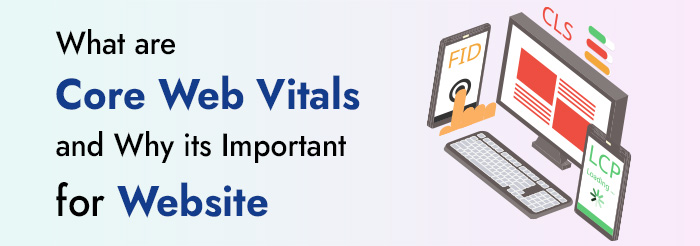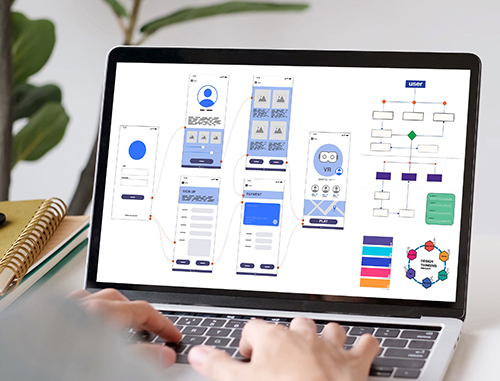What are Core Web Vitals and Why its Important for Website
Posted on
Not getting enough new patient visits and leads from your website? The problem could be your website loading speed or some other issue with your medical website design and development. Remember that healthcare consumers are every bit as impatient as other types of consumers. If your website and web pages take more than a few seconds to load, those impatient visitors will bounce and go elsewhere.
You should know that Google uses special ranking signals to measure websites. Core Web Vitals are among their most recent and important Page Experience scores. If your practice website is not optimized for these metrics, you might be damaging your search engine optimization (SEO) and overall user experience (UX).
Once you understand what Core Web Vitals are, you can take action to improve them and help ensure a solid experience for your users while meeting Google’s standards to increase search engine visibility. In this post, we’ll explain what Core Web Vitals are, why they’re important, how they work and how you can improve them.
What Are Core Web Vitals?
Core Web Vitals are key performance indicators that Google uses to measure the health and vitality of your website. For example, website loading speed is important because a slow-loading page can reduce engagement rates and increase bounce rates. This can harm not only your website’s ranking in search results, but the overall success of your practice. Ditto for web pages that are difficult to navigate.
Why Are Core Web Vitals Important?
Core Web Vitals can improve your search results. They check website loading speed and help Google understand how well your website is performing and then identify areas where it can improve. Specifically, Core Web Vitals consider loading time, interactivity and visual stability metrics. These are included in Google’s algorithms to measure the health of your website. They also consider mobile friendliness, because more people are now using mobile devices to access the Internet. If your website isn’t responsive and mobile-friendly, you are losing a lot of traffic and potential new patients. And let’s not forget the issue of website security, protecting your site and user data from online threats such as malware and hacking.
When your website meets these standards, you can get a boost in performance and rank higher in search results. By prioritizing and optimizing Core Web Vitals, you can enhance your user experience and SEO.
How Do Core Web Vitals Work?
Core Web Vitals are those factors included in Google’s Page Experience score, which is a new ranking signal introduced in 2021. Four specific measurements make up Core Web Vitals:

LCP (Largest Contentful Paint)
How long does it take for your main content to appear to visitors? LCP measures how quickly your largest content elements (i.e., your images and videos) take to load.
FID (First Input Delay)
FID analyzes the time it takes for a user’s browser to begin processing event handler interactions. FID measures the responsiveness of your web pages to users who interact with them for the first time.
CLS (Cumulative Layout Shift)
How long does it take for your web page to become visually stable? Your site elements load at slightly different times and may shift during the loading process. CLS assesses whether there are any elements on the screen that would prevent visitors from consuming your content.
FCP (First Contentful Paint)
FCP measures the amount of time it takes for a web browser to render the first piece of content (i.e., banner image) on your web page.
How Do You Measure Core Web Vitals?
Before you can improve your Core Web Vitals scores, you need to know where your website stands by doing a Core Web Vitals check. This will give you a baseline for measuring your progress. Regularly assessing your scores is a valuable part of your website maintenance.
There are a few different ways to check website loading speed and measure your website’s performance.

Google PageSpeed Insights
This is a free tool from Google. Just enter your website URL, then click the Analyze button. After this analysis, the tool will grade your site’s overall performance and provide a summary of key data and Core Web Vitals metrics. You’ll want to aim for the following scores:
LCP: 2.5 seconds
FID: Less than 100 milliseconds
CLS: Less than 0.1 second
You can test mobile and desktop versions of your website. You can also analyze individual pages. Just select the Origin tab. Your results page will also provide diagnostics and suggestions for improvement. Based on your score, PageSpeed Insights will provide recommendations that you can use to increase your score and improve your site’s performance.
Chrome User Experience Report
If you use Google Chrome, you can also perform a Core Web Vitals check through your Chrome User Experience Report. This report is available in Google Search Console and provides real data and insights from your visitors. It helps you understand how your visitors use the web and interact with your site. You can view it on your Google Search Console dashboard by navigating to Core Web Vitals under the Experience section.

Core Web Vitals Chrome Extension
The Core Web Vitals Chrome extension is a tool that helps you analyze the speed and performance of your website. It reveals your page load time, page size and requests made. It also offers suggestions about improving your website’s performance. You can also use it to test the speed and performance of any website. With the Core Web Vitals browser plugin, you can
automatically view LCP, CLS, and FID scores.
Best Practices for Improving Core Web Vitals Performance
Keep in mind that the specific actions you’ll need to take to improve your performance scores will depend on the results of your test. That’s why it’s important to consider the suggestions and recommendations provided by PageSpeed Insights. Here are some effective ways to improve your Core Web Vitals scores:
Implement a Caching Solution
By caching your content, you can reduce the load on your server. Caching stores static HTML versions of your pages, thus eliminating the need to load them every time a visitor accesses your site. Implementing a premium caching solution can be particularly helpful for improving your FID score.
Eliminate Render-Blocking Resources
Render-blocking elements are the static HTML, CSS, and JavaScript files needed to render a page on your site. Each of these files contains scripts that can prevent users from viewing your content. Typically, they’re created from third-party plugins and tools such as Google Analytics.
You can prevent these scripts from hurting your UX while improving Core Web Vitals and eliminate render-blocking resources by removing any unused CSS or scripts.

Defer JavaScript Loading
To boost your FID scores, you can use a technique known as deferring JavaScript loading. This is another way to eliminate render-blocking elements. The process makes your web pages load faster because it delays the loading of JavaScript. It loads other page content when a visitor arrives, rather than waiting for all the JavaScript files to finish loading. You can also configure your site settings so that critical CSS loads “above the fold content” more quickly. “Above the fold” refers to those elements that appear first on a web page.
Use a Content Delivery Network (CDN)
CDN is a network of servers across the globe that you can use to store your content. Your site content will be served to visitors from servers that are in closest proximity to them, which can further website loading speed times.
Size and Optimize Images Correctly
You can boost LCP scores by optimizing and compressing your images to reduce file sizes. You can do this by using tools such as TinyPNG, ShortPixel, Imagify, Smush and EWWW Image Optimizer. These image compression tools let you significantly reduce file sizes without losing quality. Optimize your images by ensuring that they are the appropriate sizes and dimensions.
The larger the image, the bigger the file size.
Implement Lazy Loading
Lazy loading helps ensure your images load exactly when users reach that section of your web page, rather than loading at the same time as everything else on the page. Lazy loading images can help improve your LCP and loading speed. For example, many WordPress image optimization plugins, such as Smush, come with lazy loading features built-in.
Optimize Your Web Fonts
The fonts you use on your website can also influence loading speed. They require the browser to download and reload the font family, including each variation of its weight combinations.
Optimizing web fonts can also help improve your website’s performance because optimized fonts use smaller file sizes that are delivered more quickly.
It pays to be selective about which fonts you choose for your site. When using more than two different fonts, you should remove them from specific elements and use global fonts to apply the needed types and weights. This will ensure that only the fonts you need for the text are downloaded.
Upgrade Your Hosting
If your site loads too slowly, it may be time to upgrade your web hosting solution. For example, switching from shared hosting to a dedicated server is an excellent way to improve your LCP.
Your hosting provider plays a pivotal role in your site’s performance, affecting everything from page speed to security. So, don’t skimp on hosting, especially if you have a large or complex website. Upgrading your hosting provider or plan is one of the quickest, most powerful ways to optimize your website and improve loading speed.
Enhance Your User’s Experience & Reap the Rewards
Remember, it’s all about your web visitors and their user experiences. Improving your user’s experience is an essential part of maintaining an effective, successful medical website. With the help of some excellent tools and plugins, this work can be a lot easier than it would have been even a few years ago.
If you need help improving your Core Web Vitals, consult a medical website design and development company like Practice Builders and take advantage of their 40+ years of experience and expertise. In addition to providing a Core Web Vitals check, they will analyze your medical practice website design, check website loading speed and help you drive more patients to your practice. To learn more, visit practicebuilders.com or call 855-898-2710.

 What Are the First Steps When Planning a New Websi..
What Are the First Steps When Planning a New Websi.. SEO Strategies to Rank Your Dental Practice
SEO Strategies to Rank Your Dental Practice How AI is Driving Patient Engagement and Revolutio..
How AI is Driving Patient Engagement and Revolutio..